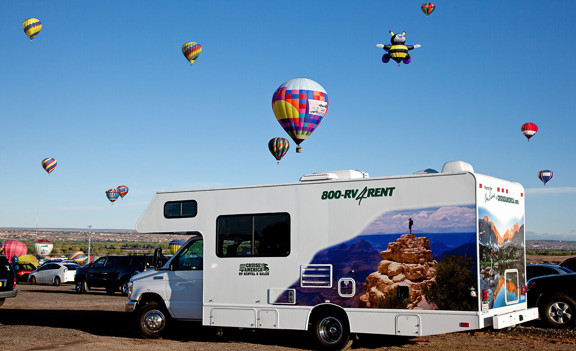Car Seats in RVs: How to Set One Up & Laws
SharePhoto Credit: Instagram User @walkerfamilygoods
Oh, the beloved family RV trip. It’s a chance to explore nature, make memories and enjoy quality time together. Since RV trips offer fun for all ages, it’s no wonder so many people are eager to embark on one.
Before heading out, make sure that a safe ride is in store for the little ones. Learn all about car seat safety in an RV below.

How to Set Up a Car Seat in an RV
-
Evaluate Your RV
First, determine whether or not your RV is suitable for a car seat. Class A motorhomes are large, but this does not mean they are safe. This is because Class A motorhomes are not required to undergo crash tests. Also, the frame and structure of these large RVs make them less safe in the event of a crash.
Class B and Class C motorhomes offer a safer option when transporting children. These vehicles sit lower to the ground, making them less likely to roll if a driver overcorrects when steering. Additionally, Class B and C motorhomes are built on van frames that are crash tested and come equipped with airbags.
All Cruise America RVs are Class C motorhomes that are built with a key focus on safety and comfort for all passengers, including the little ones. Our compact, standard and large RV rentals each include lap belts and tether attachments. These tether attachments allow you to securely fasten a child’s car seat in the RV. We’ll dive into the installation process below!
-
Locate Car Seat Friendly Seating
A car seat should be installed on a forward-facing vehicle seat. This applies to both rear-facing and front-facing car seats. This means that side facing or rear-facing seats in the RV are not suitable for a child’s car seat. Fortunately, Class B and Class C motorhomes often come with front-facing seats.
The dining area of your Cruise America RV is in the ideal location for a car seat. It offers forward facing seating and a comfortable place for up to two car seats. Here’s how to install one:
-
Simply lower the dinette to reveal a tether attachment and lap belts that you’ll use to fasten the car seat in place. Then, determine what orientation the car seat will be in. For rear-facing seats, you’ll use the lap belts built into the dining seat area to secure the seat. For forward facing seats, you’ll use the lap belts and the tether attachment built into your RV.
-
Place the car seat on top of the cushions in a forward facing position and slide the lap belt through the slot in the back of the car seat.
-
Locate the thin fastening hook on the back of your child’s car seat. Feed it through the opening at the top of the RV seat and connect it to the tether that is built into your Cruise America RV. Because the built in tether attachment is thick, the car seat hook that attaches to it must be a thin buckle. So, ensure the car seat you’re using features a thin hook before heading into the installation process.
-
Lastly, tighten the lap belts to ensure the seat won’t move around during the ride.
Proper car seat installation is a crucial step when preparing for a family RV trip. Cruise America’s guide to setting up a car seat provides an in depth explanation of this process, complete with pictures and tips.
-
Find the Right RV Car Seat
Your child's age and weight play a large role in determining what type of car seat is ideal. Explore the three main options below.
A rear-facing seat is the ideal RV baby car seat. According to the National Highway Traffic Safety Administration, this type of seat “cradles and moves with your child to reduce the stress to the child's fragile neck and spinal cord.”
For toddlers and young children, a forward-facing car seat is a secure option. The harness and tether in this model keep a child from jolting forward in the event of a crash. Cruise America vehicles provide forward facing seating options so you can ride on with peace of mind.
After a child outgrows the front-facing seat, it’s time for a booster seat. This gives the rider a lift so that the seatbelt rests in the right areas—booster seats with a high back support the child’s head and neck.
No matter what seat you choose, check to make sure that the buckle in the back of the seat features a thin hook. That way, you won’t encounter issues when installing car seats in an RV.
On top of that, follow the manufacturer guidelines for installation and use. Ensure your child is within the height and weight requirements for the seat you are using. Consult your RV owner’s manual for instructions on installing the car seat.
-
Get Help from an Expert
For peace of mind before hitting the road, connect with a car seat technician in your area. These certified professionals can inspect your car seat and ensure it is properly installed in your vehicle. If you’re having trouble securing the seat, a certified car seat technician can help you install it.
In most cases, these services come at no cost to you. Visit the National Highway Traffic Safety Administration website to find an inspection station near you.
So many families enjoy cruising in the RV with the kids If you have questions about car seat installation or safety, Cruise is here to help. Our instructional video on how to install a car seat in an RV takes you through each step of the process.
We’ve also compiled resources for you and your adventurous clan! Check out our tips for RV camping with toddlers, explore the best RV campgrounds for kids and more family friendly articles on our blog.
RV Child Seat Laws
Common questions from RVers with children include:
-
Do kids have to be in a car seat in a motorhome?
-
What are the RV seat belt laws for children?
Explore the answers to these questions and more as we browse RV child seat laws in this essential section.
When it comes to car seat requirements for kids, age and weight play a role in each state. In many states, children under 8 years of age and 40 pounds must ride in a car seat. But these requirements vary from state to state.
For instance, in Illinois, a child under the age of 8 must be in a car seat. A child under the age of 2 must be in a rear-facing car seat until they reach 40 pounds or 40 inches in height. In Nevada, a child under 6 years of age weighing less than 60 pounds must be secured in a car seat.
Explore the car seat laws by checking the Department of Transportation website in your state. Additionally, get familiar with the laws in the states you’ll be traveling to.
Hitting the road? Learn what you can and can’t do in an RV.
Much like RV car seat laws, seat belt laws for children vary by state. However, it’s always wise to ensure all passengers, especially children, are buckled up at all times. Check out our guide to RV seat belt laws for more insights.
In certain states, it’s required that a car seat is installed on a forward-facing seat. In most states, proper use is mandated. This means that car seats in an RV must be installed per the car seat manufacturer guidelines.
Because many car seat manufacturers call for front-facing vehicle seats, it’s likely that the laws in your state call for the car seat to be installed on a front-facing vehicle seat. Whether or not it’s required, placing a car seat on a front-facing seat is the safest option.
Embark on a Family Adventure in a Cruise America RV
A great RV is one that’s designed with safety in mind. At Cruise America, we add new and improved vehicles to our fleet each year. Plus, every Cruise America RV rental is custom-manufactured to our exacting specifications to be as safe, comfortable and as reliable as possible.
Browse our selection of Class C RV rentals to find the perfect fit for you and the fam!





